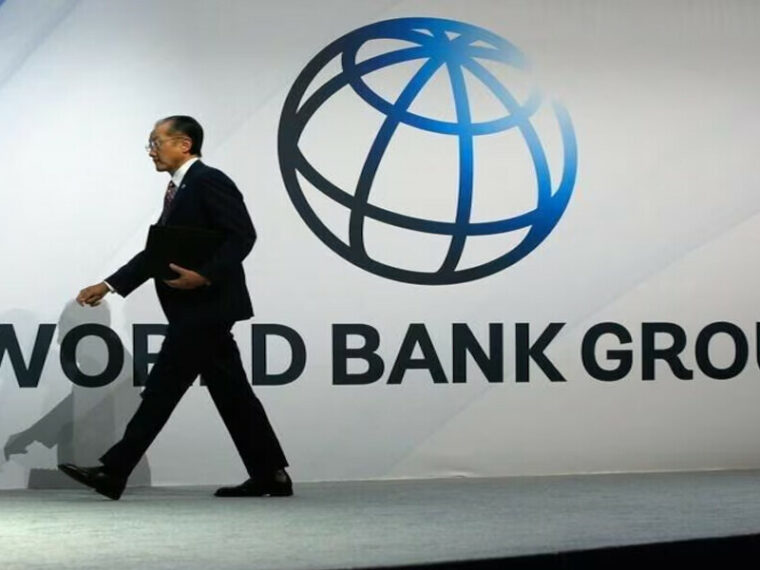The World Bank announced in its latest forecast on Tuesday that the global economy has improved compared to the beginning of the year, largely due to the strong performance of the United States. However, the optimistic outlook could be dampened if major central banks, including the Federal Reserve, maintain elevated interest rates.
Global growth for this year is projected to reach 2.6 percent annually, an increase from the January forecast of 2.4 percent, according to the bank. The global economy is nearing a “soft landing” following recent price surges, with average inflation dropping to a three-year low amidst ongoing economic expansion, stated bank economists.
Despite Americans’ ongoing concerns over high costs, which remain a key vulnerability for President Biden’s reelection prospects, the World Bank now anticipates the U.S. economy to expand by 2.5 percent annually. This is nearly one percentage point higher than its initial January prediction, making the United States the sole advanced economy demonstrating significantly faster growth than anticipated earlier in the year.
“Globally, overall conditions are more favorable today than they were just a few months ago,” remarked Indermit Gill, the World Bank’s chief economist. “Much of this improvement is attributable to the resilience of the U.S. economy.”
However, this positive assessment contrasts with the persistent concerns among many Americans about the cost of living. While the U.S. economy outpaces Europe and Japan and maintains steady job growth, inflationary pressures on items such as rent, car insurance, and beef have risen notably in recent months.
Policy measures have shown some progress. Following the Federal Reserve’s aggressive interest rate hikes, the rate of overall price increases slowed to 3.4 percent in April from a peak of 9.1 percent in mid-2022, marking the fastest pace of rate hikes in decades.
Despite this moderation, persistently high inflation levels since the early 1980s have kept consumer prices uncomfortably elevated. Overall, consumer prices have risen nearly 19 percent since President Biden took office.
These economic pressures have translated into a cautious public sentiment. Although public attitudes have improved over the past year as inflation has eased, consumer confidence in May reached its lowest level in five months, according to the University of Michigan’s monthly index. Respondents expressed concerns about the impact of high interest rates, anticipating slower job growth and weaker income gains, according to Joanne Hsu, the survey’s director.
Acknowledging the political risks, the White House has prioritized reducing costs as President Biden’s “top priority.” Biden has criticized corporations for price hikes and for using tactics like reducing product sizes to mask price increases, a phenomenon known as “shrinkflation.”
Last month, the White House credited its efforts for prompting Target and Walmart to lower prices on thousands of everyday items in response to calls for action by the president.
In a Gallup poll conducted in May, only 38 percent of U.S. adults expressed confidence in President Biden’s ability to navigate the U.S. economy effectively, marking one of the lowest presidential ratings reported by the pollster since 2001.
Meanwhile, the World Bank credited the “dynamism of the U.S.” for stabilizing the global economy despite elevated interest rates and geopolitical conflicts in Ukraine and the Middle East. The Labor Department reported last week that employers added 272,000 jobs in May, surpassing analysts’ estimates.
Nevertheless, projected global growth for this year and the next will remain below the pre-pandemic average of 3.1 percent. Three out of four developing countries are now expected to experience slower growth compared to the bank’s January forecast, offering little prospect of narrowing the income gap with richer nations.
Despite the generally positive tone, bank officials cautioned that central banks, including the Federal Reserve, are likely to proceed cautiously in reversing the past two years of interest rate increases. This suggests that global interest rates will remain elevated, averaging around 4 percent over the next two years, approximately twice the average recorded in the two decades preceding the pandemic.
Global inflation is anticipated to ease to 3.5 percent this year, dropping to 2.9 percent next year. However, the decline is proving slower than initially projected by the bank. Any setback that leads monetary authorities to delay reductions in borrowing costs could shave off 0.3 percentage points from forecasted growth rates.
“This represents a significant risk facing the global economy — prolonged high interest rates could weaken an already modest growth outlook,” cautioned Gill.
Bank officials also highlighted concerns regarding global trade, which is on track to record its weakest performance over a five-year period since the 1990s. In 2024 alone, trading nations have implemented over 700 restrictions on merchandise trade and nearly 160 barriers to services trade.
“The surge in trade restrictions is alarming, having more than doubled since the pre-pandemic era,” noted Gill.
Rising protectionism poses a potential drag on the global economy’s already tepid growth pace. With popular support for tariffs on imported goods and domestic production subsidies in many countries, trade flows could face further constraints amid heightened U.S.-China tensions and other geopolitical risks.
“There’s a risk that the world may find itself stuck in a sluggish lane,” warned Ayhan Kose, the bank’s deputy chief economist.
Among those most vulnerable if key interest rates remain elevated are the 40 percent of developing countries at risk of a debt crisis. Many borrowed heavily during the pandemic to finance healthcare responses and subsequent rises in food and fertilizer costs following the conflict in Ukraine.
Gill remarked that these countries have little immediate prospects for debt relief and face the possibility of missing out on trade benefits as larger economies turn inward.





